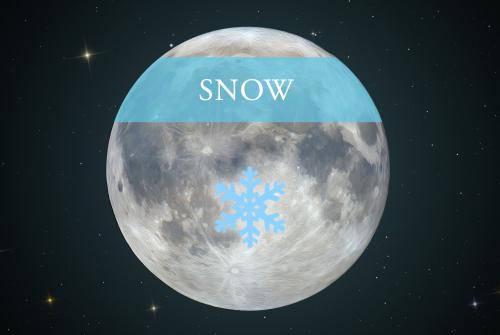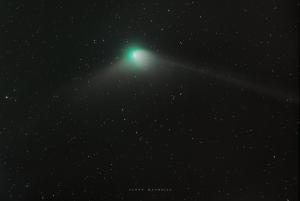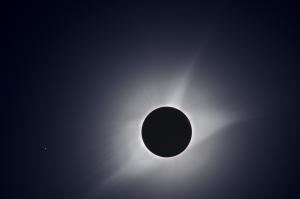Celebration of Space - February 23, 2024
Tomorrow morning, Saturday, February 24, 2024, at 7:31 am EST, the February full Moon will occur. This happens every 29.5 days, when the Moon orbits into a position around Earth where it arrives on the opposite side of Earth than the Sun. This is an alignment, which increases the gravitational pull on Earth causing an exaggeration in the tide, known as the Spring Tide. During the full Moon, sunlight will shine past Earth and illuminate the entire side of the Moon that faces us, leaving the other side of the Moon in darkness.
The February full Moon is commonly referred to as The Full Snow Moon, which makes sense, at least for the more northern regions of the Northern Hemisphere. February is generally the month of the year that brings the most snow to these regions. Other names that the February full Moon has gone by include the Eagle Moon, Bear Moon, Raccoon Moon, and Groundhog Moon. According to the Old Farmer’s Almanac, the Cherokee tribe called the February full Moon the Bony Moon and the Hungry Moon, which is related to food scarcity during February. Regardless of what you call the February Moon, it will be a worthy view, especially when rising. Southern New England will be clouded out, but if you have a clear view of the eastern horizon at sunset this afternoon (Friday, February 23, 2024) you can catch a view of the full Moon rising. Be out and looking at 4:35 pm.
This coming April, an old visitor will be returning to the inner Solar System. Comet 12P/Pons-Brooks (12P), which is a periodic comet, will swing back around the Sun and pay a visit to Earth. Being that Comet 12P is a periodic comet, it has a mere 71 year orbital period. It is also one of the brightest periodic comets that we get to see here on Earth.
In 2024, Comet 12P will make its perihelion passage, which is its closest approach to the Sun, on April 22, 2024 ET (April 23 UT) at a distance of 72,181,934 miles from the Sun, which is about 78% the distance of Earth from the Sun. After perihelion, Comet 12P will swing by Earth on June 2, 2024 at a distance of 144,158,000 miles, which is further than the Sun from Earth. Sorry doomsayers, no impact scenario here. Even though the comet will not pass close to Earth or the Sun, when compared to other bright comets, the orientation of the comet’s orbit, which is perpendicular to the orbit of Earth, and the placement of the comet around the Sun, will allow for excellent views of the comet’s tail. At this time the comet is predicted to become almost naked eye visible, but this comet is quite known for producing outbursts, and if one happens near perihelion, the comet could become easily naked eye visible.
Here is the bonus! The timing of all this just happens to coincide with the fabulous solar eclipse that will happen on April 8, 2024. On that date, the comet will be placed in the sky about 22° eastward of the Sun. For those who are along the path of totality, which is where one would experience a total solar eclipse, during the time of totality, Comet 12P could be visible to the naked eye in the sky, placed about 6° west of Jupiter. There are still a few variables and timings that need to work out, like an outburst event in the days before the eclipse. Worse case scenario, we don’t see the comet naked eye during the eclipse, but have spectacular views in telescopes during the months of April – June. In any case, we will keep you updated on Comet 12P’s status as the eclipse approaches.
Starting Tuesday, February 27, 2024, the China National Space Administration Tiangong space station will commence evening passes over the US. Being that Tiangong is a modular station, it continues to grow, and has become nearly as bright as the ISS in the evening sky. Tiangong orbits Earth at a different inclination than the ISS, which gives us better pass altitudes over our region, making it common to see the station high in the sky. Here are a couple notable passes for the coming week:
Tue, Feb 27 at 6:49 pm, starting in the SSW, rising to 20°, heading towards the SSE, and into orbital sunset
Wed, Feb 28 at 7:24 pm, starting in the WSW, rising to 32°, and into orbital sunset
Thu, Feb 29 at 6:23 pm, starting in the SW, rising to 31°, heading towards the E, and into orbital sunset.
Note that these passes should work for any viewer located in the Northeast. Evening passes of Tiangong will continue daily until March 11, 2024. For pass times of Tiangong and other bright satellites, visit the Frosty Drew Daily Satellite Pass Prediction Utility.
For those with a clear view of the sky tonight, there will be a stunning pass of a Starlink constellation which launched this morning (February 23, 2024). If you haven’t observed a pass of Starlink, then you are missing out. Depending on how long after the launch one is viewing, you can see anything from a closely grouped line of satellites passing over, to a long stretch of satellites crossing the sky. The best times to view are closer to the launch, which places tonight’s pass at optimal. To catch a view, step outside at 6:43 pm, and look to the NW. Satellites will start becoming visible the higher they rise, and they will pass overhead at 68° above the horizon, heading towards the E, and then quickly fade into Earth’s shadow. Let us know if you happen to see the constellation.
- Author:
- Scott MacNeill
- Entry Date:
- Feb 23, 2024
- Published Under:
- Scott MacNeill's Columns





